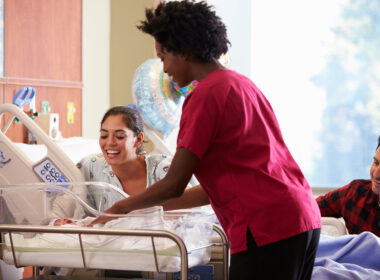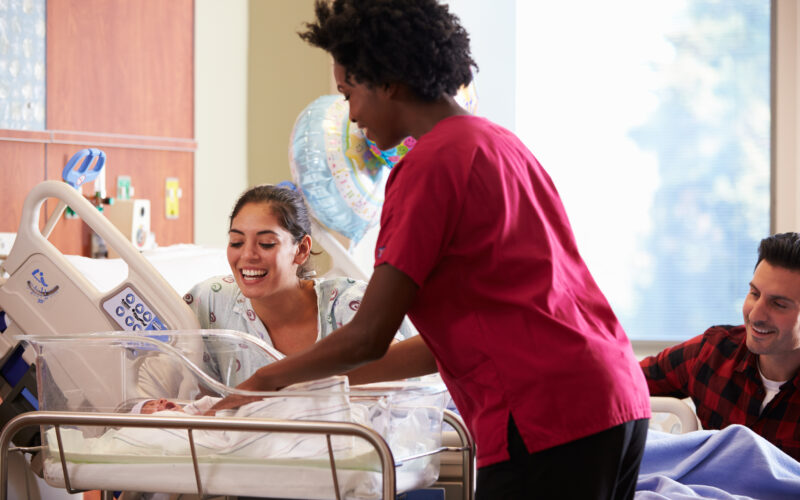When I was pregnant with my oldest, there was so much to learn and so many questions to ask. I was comfortable with my OBGYN practice and confident in my healthcare professional there, so my husband and I didn’t look too closely at the practices of our chosen hospital. My pregnancy was low-risk, and we knew many others who had good experiences delivering there.
Naive to the world of labor, delivery, and postpartum, I was under the impression that low-intervention labor and support for breastfeeding would be everyone’s priority. After all, it was easy enough for мне to understand the benefits of естественные роды и Кормление грудью, and I wasn’t even a medical professional.
My birth and breastfeeding journeys
The birth of our oldest was a cascade of interventions; not at all what I had hoped. My breastfeeding journey was equally misleading and frustrating. After appointments with the hospital lactation consultants, attempt after attempt to help our oldest latch and transfer milk, and so many tears, my husband and I agreed that bottle feeding expressed breast milk was best.
With our second child, we did our research, hired a доула, wrote and discussed a detailed birth plan with our healthcare professional, and felt more confident. Our second’s birth story was much better, but our breastfeeding journey found us back at bottle feeding expressed breast milk. After 26 months of pumping to bottle feed expressed breast milk, my husband and I agreed that the breastfeeding journey with our third baby needed to look different.
Halfway through my third pregnancy we moved, which required searching for a new healthcare professional and choosing a new hospital for delivery. With only two hospitals to consider, I began doing my research and settled on the hospital where my prenatal care could be through a midwife and where the facility maintained a Baby-Friendly designation.
Baby-Friendly (BFHI) designated facilities
Prior to my third pregnancy, I had not heard of a Baby-Friendly Hospital Initiative (BFHI) facility. However, in recent years, Baby-Friendly designations have climbed to approximately 600 certified facilities in the United States and more than 20,000 maternity facilities worldwide.
The Baby-Friendly designation by the BFHI refers to the policy and procedure after a baby is delivered, directed towards a successful breastfeeding journey for mothers and babies. BFHI is a global effort through UNICEF and the World Health Organization (WHO) to designate facilities that are implementing practices they believe protect, promote, and support breastfeeding. Baby-Friendly USA recognizes United States birthing facilities that have achieved the Baby-Friendly status outlined by global BFHI standards and the USA specific standards.
The Baby-Friendly designation by the Baby Friendly Hospital Initiative refers to the policy and procedure after a baby is delivered, directed towards a successful breastfeeding journey for mothers and babies. BFHI is a global effort through UNICEF and the World Health Organization (WHO) to designate facilities that are implementing practices they believe protect, promote, and support breastfeeding.
Baby-Friendly USA’s Ten Steps to Successful Breastfeeding
Baby-Friendly USA has outlined Ten Steps to Successful Breastfeeding, which are the ten steps hospitals and birthing facilities must adhere to to receive and retain a Baby-Friendly designation in the initial 5-year designation cycle, and thereafter in a 2-year redesignation process. The Ten Steps, reproduced below, include two critical management procedures, and eight key clinical practices:
Critical management procedures
- Facility Policies
- Comply fully with the International Code of Marketing of Breast-milk Substitutes and relevant World Health Assembly resolutions.
- Have a written infant feeding policy that is routinely communicated to staff and parents.
- Establish ongoing monitoring and data-management systems.
- Ensure that staff have sufficient knowledge, competence and skills to support breastfeeding.
Key clinical practices
- Discuss the importance and management of breastfeeding with pregnant women and their families.
- Facilitate immediate and uninterrupted skin-to-skin contact and support mothers to initiate breastfeeding as soon as possible after birth.
- Support mothers to initiate and maintain breastfeeding and manage common difficulties.
- Do not provide breastfed newborns any food or fluids other than breast-milk, unless medically indicated.
- Enable mothers and their infants to remain together and to practice rooming-in 24 hours a day.
- Support mothers to recognize and respond to their infants’ cues for feeding.
- Counsel mothers on the use and risks of feeding bottles, artificial nipples (teats) and pacifiers.
- Coordinate discharge so that parents and their infants have timely access to ongoing support and care.
Surprising things the BFHI designation не требуется
Surprisingly, these Ten Steps do не require certified lactation consultants to be on staff; instead, 80% of all labor and delivery, postpartum and/or newborn direct care providers must be competent in several facets of helping mothers in the nourishing and nurturing of their babies. These include:
- How to assist a mother in the steps to getting her baby to latch
- How to discuss with a mother how breastfeeding works
- In helping a mother to breastfeed a late-preterm baby
- In helping a mother prevent or resolve difficulties with breastfeeding
- In helping a mother manage milk expression
- In helping a mother who is not feeding her baby directly at the breast”
Do Baby-Friendly facilities require breastfeeding, ban pacifiers, or demonize formula feeding?
Common misunderstandings of Baby-Friendly designated facilities tend to center around thinking the facility requires breastfeeding, does not allow pacifiers, or demonizes formula. In truth, Baby-Friendly facilities have policies and protocols in place to ensure mothers have the education and resources available to make an informed decision about how to nurture and nourish their baby без the interference of commercial marketing and product placement that frequently occur in hospitals due to formula industry influence.
Breastfeeding, while mutually beneficial for moms and babies, is physically, mentally, and emotionally draining in the initial days and weeks postpartum. In communities that may not prioritize or appreciate breastfeeding, it can also cause social stress for both mom and baby. Beyond care provided by Baby-Friendly designated facilities for the first 24-48 hours of a baby’s life, mothers and babies need a supportive community around them for the duration of breastfeeding to make it a possibility.
Follow-up care and support looks different in every community, and while the Baby-Friendly designation requires facilities to link mothers to lactation-support resources in their local community upon discharge, these рекомендации are based on what support systems exist in your community through “primary health-care centers, community health workers, home visitors, breastfeeding clinics, nurses/midwives, lactation consultants, peer counsellors, mother-to-mother support groups, or phone lines (“hot lines”).”
While it is a Baby-Friendly designated facility’s goal to ensure a successful breastfeeding journey, mothers birthing at a Baby-Friendly facility are not required to breastfeed nor is the success of their breastfeeding journey guaranteed.
Does a Baby-Friendly designation matter?
Studies are conflicted on whether or not Baby-Friendly designation actually matters when it comes to the success of a breastfeeding journey and the health of mom and baby.
Recent articles published in Women and Birth а также Journal of Neonatal Nursing note a significant difference in breastfeeding rates and maternal satisfaction among mothers who have experienced the Breastfeeding Hospital Initiative (BFHI) compared to mothers who have not [1][2].
However, the Center for Women’s Mental Health raises the question: Does Baby-Friendly Have to Be Mom-Unfriendly? Stating that, “While these [BFHI] recommendations are based on solid scientific research and are designed to promote and support breastfeeding, the rigidity and specificity of these guidelines may place undue pressure on new mothers and may be overly demanding” (Center for Women’s Mental Health, 2017)
The Center for Women’s Mental Health raises the question: Does Baby-Friendly Have to Be Mom-Unfriendly? Stating that, “While these [BFHI] recommendations are based on solid scientific research and are designed to promote and support breastfeeding, the rigidity and specificity of these guidelines may place undue pressure on new mothers and may be overly demanding.
Massachusetts General Hospital earned its Baby-Friendly designation in 2016, and since earning the designation, the hospital has “heard stories from mothers who have found the new baby-friendly approach to be less than friendly to new moms” (Center for Women’s Mental Health, 2017).
A 2016 publication by JAMA Pediatrics concludes that “Unfortunately, there is now emerging evidence that full compliance with the 10 steps of the [Baby Friendly] initiative may inadvertently be promoting potentially hazardous practices and/or having counterproductive outcomes” [3]
Lindsay Cantwell of Montana State University agrees after completing a study seeking to improve sleep opportunities in hospitalized postpartum mothers (Cantwell, 2022). Cantwell (2022) accepts “the Baby-Friendly Hospital Initiative creates many benefits for breastfeeding and mom/infant bonding, but maternal recovery needs are often not addressed.”
Cantwell (2022) asserts that, “Ideally, this [Baby-Friendly] care model should incorporate intentional nursing strategies to promote rest and recovery for new moms following delivery while maintaining baby-friendly care.”
Cantwell’s findings underscore the critical relationship between poor sleep and increased risks of postpartum depression and other adverse health outcomes. Cantwell notes that “The paradigm practice change in hospitals from nursery-assisted care to Baby-Friendly care has likely contributed to the exacerbation of maternal postpartum sleep disruption due to infant-caregiving duties” and proposes the Baby-Friendly Hospital Initiative continues with the rooming-in protocol and incorporate an offer of quiet time the nurses can offer and chart as offered and accepted, or offered and patient declined (Cantwell, 2022).
In our experience
The postpartum plans for our second baby—not birthed in a Baby-Friendly designated hospital—included rooming-in and all tests, care, etc. be done in our room or presence. This plan was respected and our newborn was with us for the entirety of our hospital stay. While I do not remember our level of fatigue, I do remember the lack of assistance with latching our newborn. The staff was quick to suggest I pump and bottle feed expressed breastmilk if breastmilk was our plan.
We left that postpartum hospitalization experience feeling respected but not supported.
The postpartum plans for our child birthed in a Baby-Friendly designated hospital also included rooming-in and all tests, care, etc. to be done in our room or presence. This plan was respected; however, when the option to have a test done out of our room was given, we agreed to let the test be done out of my room. With the support of Rachel—the lactation consultant who guaranteed she would walk with me for as long as needed so I would be able to feed this baby at the breast—I nursed our newborn immediately before the brief test. It gave me time to rest and breathe knowing our newborn would be brought back immediately should she show signs of hunger or distress.
Even now, I remember how a short 30 minute “quiet time” (Cantwell, 2022) in our 24-hour stay made a significant difference in my well-being.
We left that postpartum hospitalization experience feeling respected, supported, and equipped.
Perception matters
A 2022 publication in Midwifery has the pulse on the benefits and pitfalls of Baby-Friendly designations, summarizing that, while their study results indicate that a BFHI designation improves breastfeeding outcomes, “Maternal perceptions about the impact of BFHI designation are important to consider because mother–infant dyads are at the centre of that support, and their viewpoint may help to assess whether the designation to the BFHI in the unit is successful.” [4]
What the mom and baby experience in the hospital and how respected, supported, and equipped they feel leaving the hospital matters most.
What the mom and baby experience in the hospital and how respected, supported, and equipped they feel leaving the hospital matters most.
When your goal is to breastfeed
If breastfeeding is your nurturing and nourishing goal and you are birthing in a Baby-Friendly designated facility, their policies, protocols, and resources may increase the success of breastfeeding without adding to your mental load during labor, delivery, and postpartum recovery. Yet, it may still be important to advocate for your rest as a mom to a newborn.
For expectant moms not birthing at a Baby-Friendly designated facility for whom breastfeeding is your nurturing and nourishing goal, it is typical to tour your birth facility around 30 weeks pregnant (for first time moms). Whether touring or simply calling the Labor and Delivery unit, plan to ask about the birthing facility’s policies, particularly around skin-to-skin, lactation support, rooming-in, couplet care, and formula supplementation. This information will aid in helping you craft (and Dad to support) a postpartum plan specific to you and your baby’s nurturing and nourishing goals regardless of the birthing facility’s standard practices.
What if you’re not going to breastfeed?
If breastfeeding is not your plan or you are preparing for a challenging feeding journey (possibly due to your or your baby’s health needs, employment situation, etc.), Baby-Friendly designated facilities have plans to support that journey. These plans include teaching about hygienic expression of breast milk or safe preparation of infant formula, as well as safe storage of expressed breast milk and/ or infant formula.
The bottom line: Should you give birth at a Baby Friendly Facility?
While the Baby-Friendly hospital experience was a fit for my birth plan, it’s important to look at all the facts. Are the Baby-Friendly clinical practices consistent with your plans for birth and breastfeeding? Do the strengths outweigh the criticism in your estimation? And, very importantly, after visiting with and questioning your local hospital, do you feel safe and supported? Choosing the right facility for your baby’s birth is not always cut and dry–Baby-Friendly facilities may be one option for you as you make a decision.






